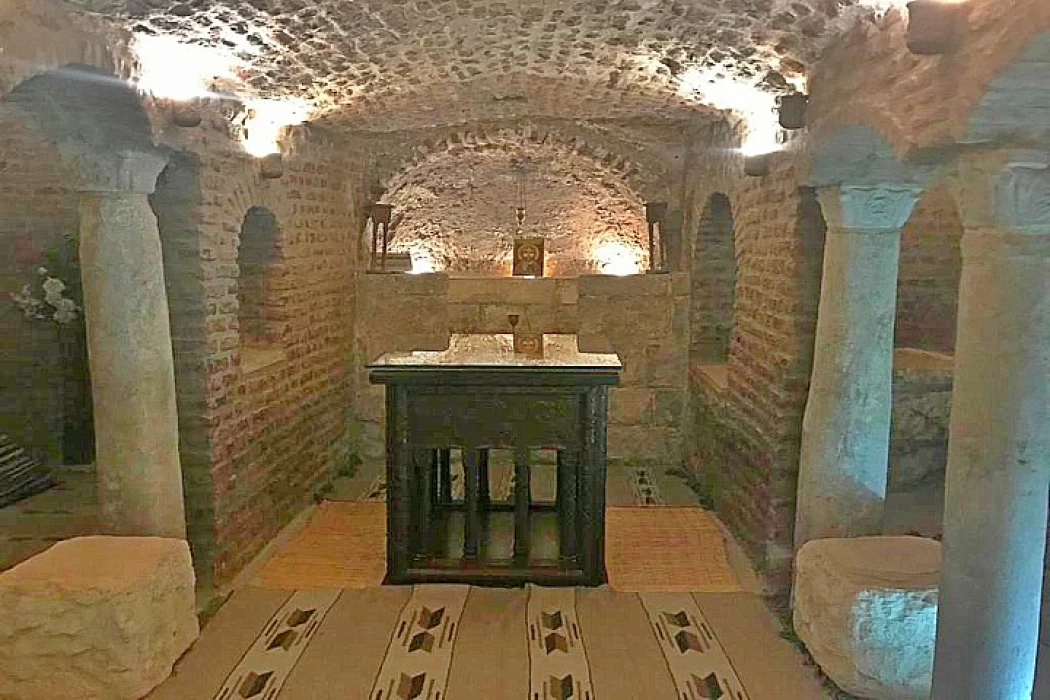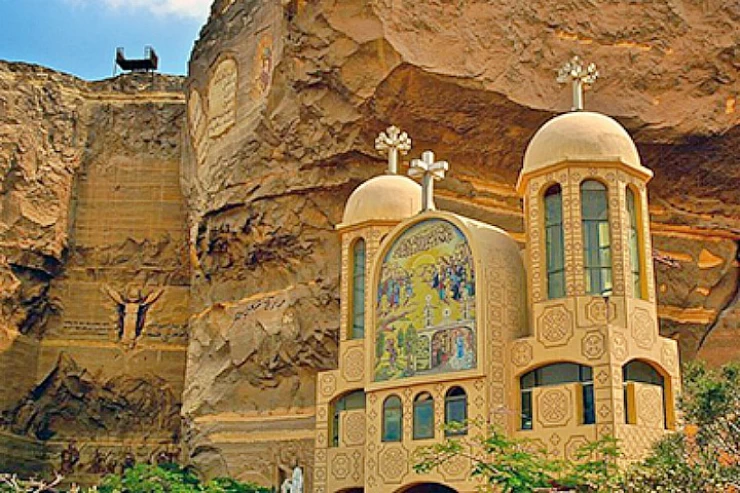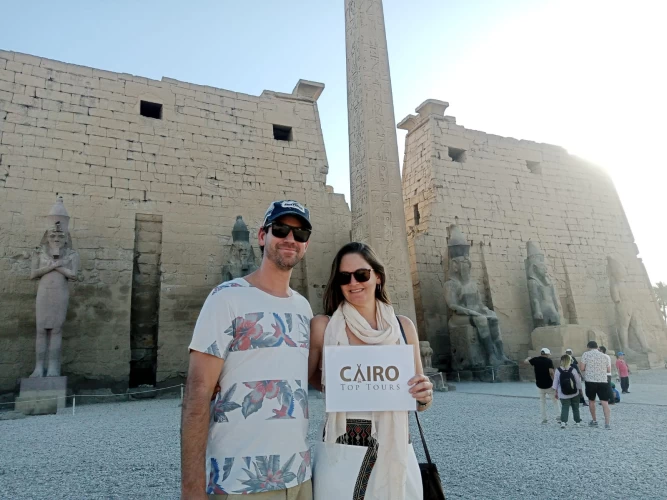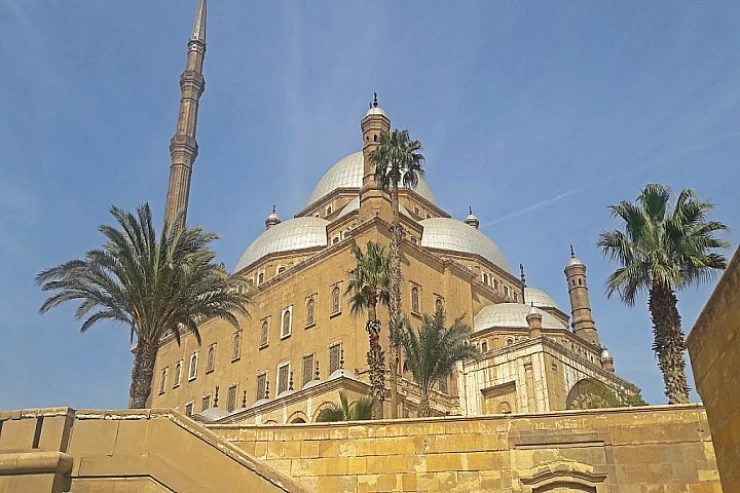
Iglesia de San Sergio y Baco

La iglesia de San Sergio o Abu Serga fue construida en el centro del antiguo fuerte romano de Babilonia en el Cairo copto, no lejos de la sinagoga de Ben Ezra. Fue visitado por la Sagrada Familia durante su fuga del rey Herodes a Egipto.
La iglesia de San Sergio data del siglo V, aunque algunos historiadores creen que en realidad fue construida en el siglo VIII. El origen de San Sergio es incierto, pero hay dos santos con el mismo nombre. El primero fue un egipcio que murió durante la persecución cristiana, junto con su padre y su hermana. La gente hoy celebra su memoria todos los años el 7 de febrero . El segundo era un sirviente del emperador romano Maximiliano, y fue martirizado en Siria a principios del siglo IV.
La forma de la iglesia es la de una basílica con un nártex, una nave y 2 pasillos. Están separados de la nave por 12 columnas con capiteles corintios, 10 de piedra, una de mármol y otra de granito en roseta.
Hay 3 santuarios en el lado este; Cada santuario contiene un altar, con una cúpula de madera, sostenido por 4 columnas de mármol. La cúpula de cada altar tiene escenas religiosas de Cristo, los ángeles y los 4 evangelistas. Hay un púlpito en el lado noreste de la nave, que está hecho de mármol, aunque originalmente estaba hecho de madera, con incrustaciones de ébano y marfil.
El púlpito se usa una vez al año en la oración del Gran Viernes. El santuario de pantalla de madera data del siglo XIII. Tiene paneles de remolque de ébano y marfil.
Una de las partes más importantes de esta iglesia es la cueva en la que se alojó la Sagrada Familia durante su viaje a Egipto . Tiene una nave y 2 pasillos y el techo es abovedado. Al final del pasillo sur de la Cueva, hay un baptisterio.
La Iglesia es un lugar imperdible incluido en cualquier excursión de un día a El Cairo .
En la ciudad de El Cairo, en el país de Egipto, hay un lugar especial llamado Sakakini Palace. Puedes aprender muchas cosas interesantes sobre él.
Among the manifold historical and cherished structures across Cairo is one of the oldest and most significant statues for Christians, which is the Church of St. Sergius and Bacchus, known as Abu Serga. This old church that is later believed to have existed in the pairs of the fourth century is more than just a worship center for Coptic Christians but a crucial aspect in understanding the religious history of the land of Egypt. Thanks to its association and breathtaking history and architecture, Abu Serga is still a site of worship and pilgrimage for many who come to Egypt from different corners of the globe.
The church of Saint Serga and Bacchus is situated around the Coptic Quarter in Cairo together with other places of Christian importance such as The Hanging Church and The Ben Ezra Synagogue; thus, it is advisable to visit the church for those people who wish to get acquainted with the rarely seen Christian aspect of Egypt.
The church located within the so-called Byzantine walls is dedicated to Saint Sergius and Bacchus, two martyrs who were soldiers in the Roman army under Emperor Maximian himself. It had been fashionable to venerate them in the Eastern Roman Empire during the reign of the growing adversary of Christianity since both suffered from its persecutions. There was even a widespread narrative among early Christians of the suffering of the saints, surrounding such instances of persecution and martyrdom. Thus, this church was built as one of its memorials and is highly associated with the saints’ narrative.
However, the most remarkable one is in connection with the Holy Family: Mary, Joseph, and baby Jesus on their flight to Egypt. It is said in Coptic that the Holy Family sought shelter in a cave under the church during the reign of King Herod. This has turned the church into a popular site of pilgrimage in Egypt, particularly among the Copts who respect the Holy Family for its protective travel.
The Crypt: A Sacred Refuge of the Holy Family
One of the noteworthy and spiritually deepened characteristics of the Church of Saint Sergius and Bacchus is its underground crypt, which is thought to have been the place where the Holy Family stayed while in Egypt. The crypt is situated at a depth of approximately 10 meters and is the focus of many church devotees.
The Very Revered One’s Cafe is a great break from the rather shaky feeling of intimidation. As one enters the low, narrow, dark passageway, the history around them seems to be overwhelming. The crypt is rather small, with just an altar at the spot where the Holy Family is believed to have spent some time. Many visitors bow down in this place, which is so called the Thanksgiving for the Holy Family, praying for the needs of the people who have come for their aid.
The crypt moreover serves to elevate the mystery and the sacredness of the church, as well as floods during the seasons of high Nile waters. For Christians traveling to Egypt, the moment one stands where the Child Jesus was most likely kept is an experience that is impossible to forget.
While the Church of Saint Sergius and Bacchus is less extravagant than most Christian cathedrals, what it lacks in embellishments is more than compensated by its architectural grace that has stood the test of time. The geometric layout of the church is designed in a classic basilica configuration, whereby there is a single central nave, two lateral aisles, and 12 towering pillars that are representative of the 12 apostles. And the wooden ceiling, crafted in the form of the Ark of Noah, resonates with the self-interpretation of the church as a haven.
The church’s interior design and decoration are characterized by the presence of the most beautiful element, which is the iconostasis, or the wooden wall separating the altar from the church. The icons on this screen, which show various biblical scenes and Coptic saints, are striking to the point of making one forget everything and engage in silence. In the center of the temple, just above the altar, there is a large icon of Christ Pantocrator, also known as Christ the All-Powerful, who is directing his gaze on the people in the church.
The interiors of the church are decorated with both ancient frescoes and iconographic paintings, most of them painstakingly preserved for ages. These religious artworks can be likened to masterpieces in aesthetics but are in fact canvas for picturing the Christian religion to include their beliefs and devotion, which extends the sanctity of the space.
As a result of this consideration, the design philosophy of the church contains unusual decor owing to the church’s design stressing more on the spirituality achieved than the decorative aspects. This enhances the tranquil and contemplative atmosphere of the church and is most desirable for individuals wishing to engage in silent prayer or reflection.
The Church of Saint Sergius and Bacchus is of great importance, not only to Coptic Christians but to the entire body of Christ. It ranks as one of the most important locations on the Holy Family Trail, a pilgrimage path that honors the different sites within Egypt that the Holy Family is said to have visited.
Visitors from all over Egypt and the world come to Abu Serga church to pay their respects to the Holy Family, pray in the shrine, and take part in religious services. This church is most crowded during the Feast of the Holy Family, which is celebrated every June 1st, as many people come to the church to remember how the Holy Family fled to Egypt.
In addition, the temple functions as a working church for the Coptic community residing in Cairo. It is here that regular services, masses, and other religious festivities are conducted, in which the congregants come together to express their beliefs and stay in touch with the early Christian saints and Christ’s family.
The Church’s Role in Coptic Cairo
One of the focal points of Coptic Cairo is the Church of Saint Sergius and Bacchus, which is located in a neighborhood that boasts some of the most significant Christian and Jewish sites in Egypt. Coptic culture is an important aspect of Egypt, which had its rich history long before the advent of Islam, and it is fully appreciated the impact of that religion in Egypt today.
Abu Serga is located next to some of the other famous sites of Coptic Cairo, including The Hanging Church, famous for its beautiful nave ‘hanging’ in the air, and the Coptic Museum, which contains a treasure trove of Christian relics, manuscripts, and artworks. The visitors to the church also visit these sites, which helps in understanding the Coptic Orthodox religion and its history in Egypt better.
The church likewise represents the harmonious existence of religions within Egypt because the Ben Ezra Synagogue, one of the oldest synagogues in Egypt, is located next to it. This only gives credence to the claim that for a long time, Egyptians were very tolerant of other religions.

















